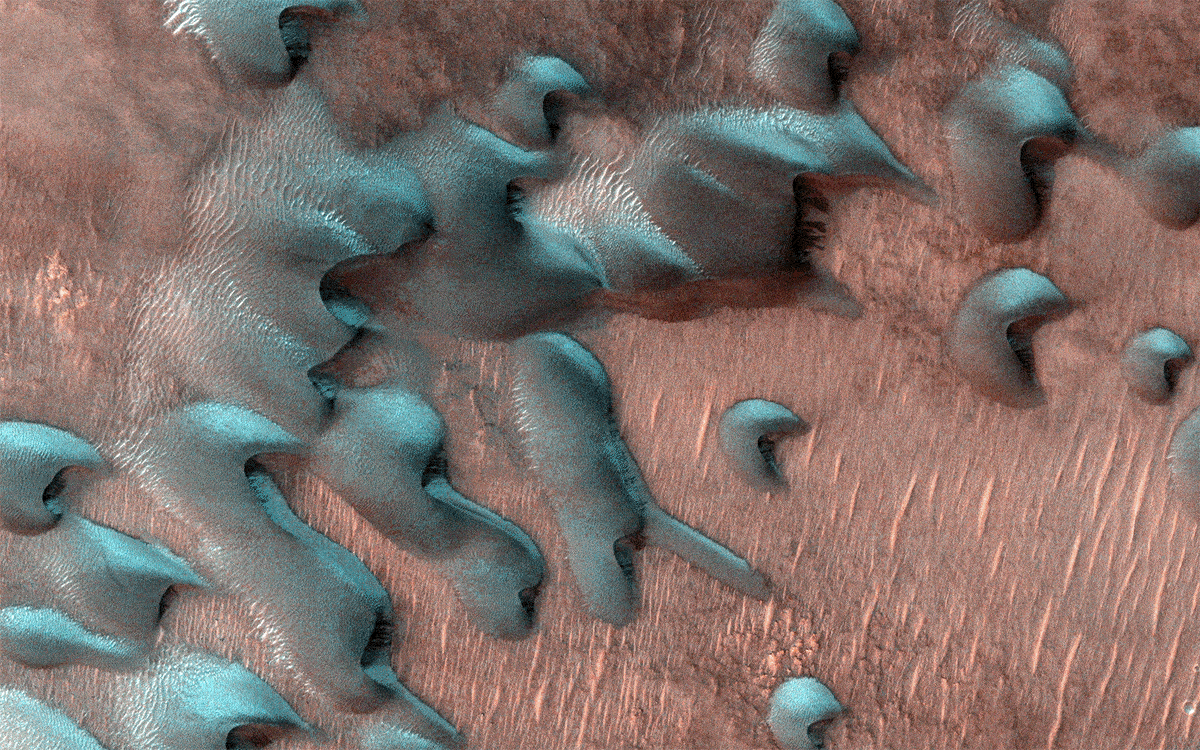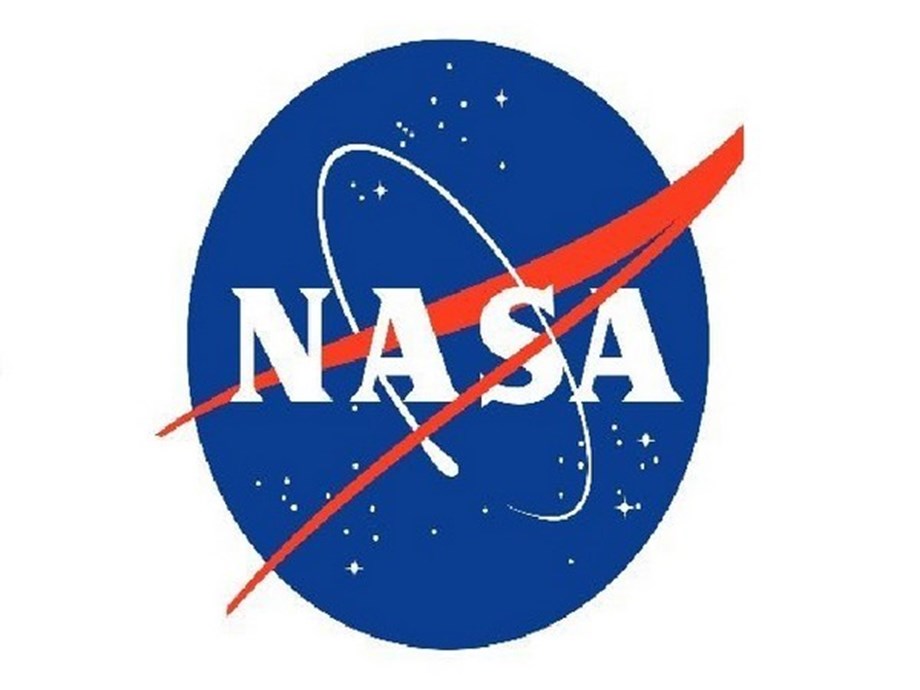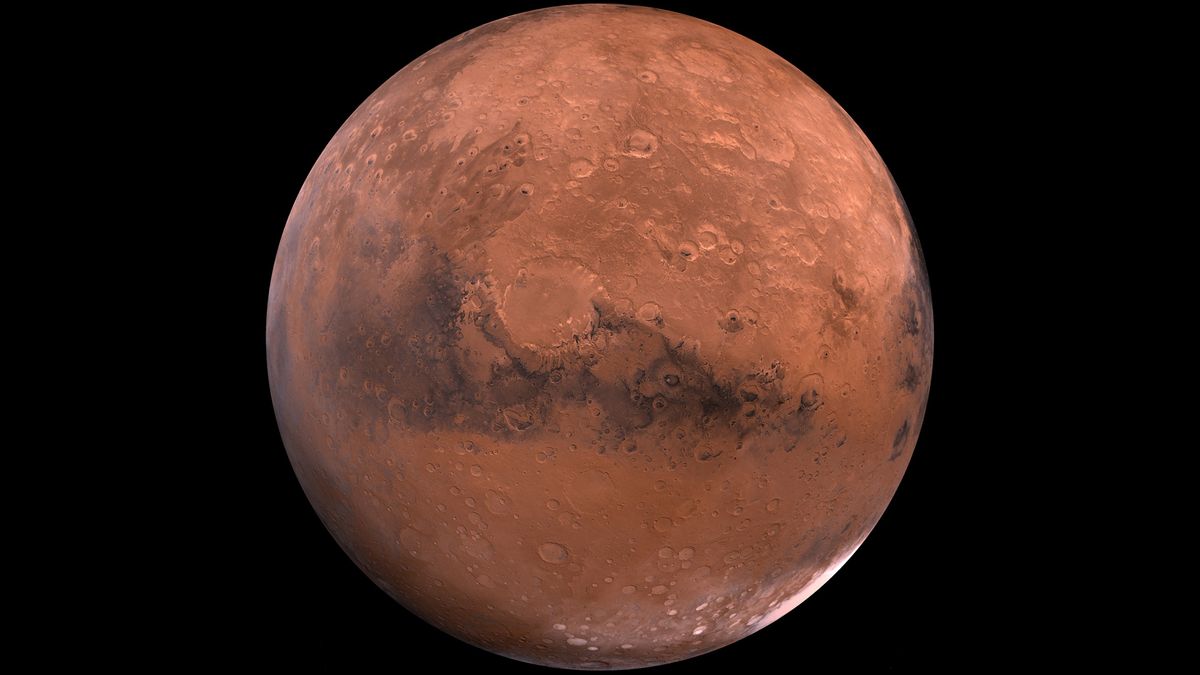Kamera HiRISE na pokładzie sondy Mars Reconnaissance Orbiter wykonała te zdjęcia pokrytych szronem wydm tuż po przesileniu zimowym. Szron jest tu mieszaniną dwutlenku węgla (suchego) lodu i wody śnieżnej i zniknie za kilka miesięcy, gdy nadejdzie wiosna. Źródło obrazu: NASA/JPL-Caltech/University of Arizona
Śnieg w kształcie sześcianu, lodowe krajobrazy i mróz są częścią najzimniejszej pory roku na Czerwonej Planecie.
Kiedy nadchodzi zima[{” attribute=””>Mars, the surface is transformed into a truly otherworldly holiday scene. Snow, ice, and frost accompany the season’s sub-zero temperatures. Some of the coldest of these occur at the planet’s poles, where it gets as low as minus 190 degrees Fahrenheit (minus 123 degrees Celsius).
Cold as it is, don’t expect snow drifts worthy of the Rocky Mountains. No region of Mars gets more than a few feet of snow, most of which falls over extremely flat areas. And the Red Planet’s elliptical orbit means it takes many more months for winter to come around: a single Mars year is around two Earth years.
Śnieg, lód i szron tworzą się również na Marsie.[{” attribute=””>NASA’s spacecraft on and orbiting the Red Planet reveal the similarities to and differences from how we experience winter on Earth. Mars scientist Sylvain Piqueux of JPL explains in this video. Credit: NASA/JPL-Caltech
Still, the planet offers unique winter phenomena that scientists have been able to study, thanks to NASA’s robotic Mars explorers. Here are a few of the things they’ve discovered:
Two Kinds of Snow
Martian snow comes in two varieties: water ice and carbon dioxide, or dry ice. Because Martian air is so thin and the temperatures so cold, water-ice snow sublimates, or becomes a gas, before it even touches the ground. Dry-ice snow actually does reach the ground.
“Enough falls that you could snowshoe across it,” said Sylvain Piqueux, a Mars scientist at NASA’s Jet Propulsion Laboratory in Southern California whose research includes a variety of winter phenomena. “If you were looking for skiing, though, you’d have to go into a crater or cliffside, where snow could build up on a sloped surface.”

HiRISE captured these “megadunes,” also called barchans. Carbon dioxide frost and ice have formed over the dunes during the winter; as this starts to sublimate during spring, the darker-colored dune sand is revealed. Credit: NASA/JPL-Caltech/University of Arizona
How We Know It Snows
Snow occurs only at the coldest extremes of Mars: at the poles, under cloud cover, and at night. Cameras on orbiting spacecraft can’t see through those clouds, and surface missions can’t survive in the extreme cold. As a result, no images of falling snow have ever been captured. But scientists know it happens, thanks to a few special science instruments.
NASA’s Mars Reconnaissance Orbiter can peer through cloud cover using its Mars Climate Sounder instrument, which detects light in wavelengths imperceptible to the human eye. That ability has allowed scientists to detect carbon dioxide snow falling to the ground. And in 2008, NASA sent the Phoenix lander within 1,000 miles (about 1,600 kilometers) of Mars’ north pole, where it used a laser instrument to detect water-ice snow falling to the surface.
Naukowcy z NASA mogą zmierzyć rozmiar i kształt rozkładu cząstek śniegu warstwa po warstwie podczas burzy. Global Precipitation Measurement Mission to międzynarodowy projekt satelitarny, który zapewni następną generację obserwacji światowego deszczu i śniegu co trzy godziny. Źródło: Goddard Space Flight Center NASA/Ryan Fitzgibbons
kostki lodu
Ze względu na sposób, w jaki cząsteczki wody wiążą się ze sobą, gdy zamarzają, płatki śniegu na Ziemi mają sześć boków. Ta sama zasada dotyczy wszystkich kryształów: sposób, w jaki atomy się organizują, określa kształt kryształu. W przypadku dwutlenku węgla cząsteczki suchego lodu zawsze łączą się w czwórki po zamrożeniu.
„Ponieważ lód z dwutlenku węgla ma symetrię 4, wiemy, że suche płatki śniegu będą miały kształt sześcianu” – powiedział Bicchio. „Dzięki marsjańskiemu klimatowi jest bezpieczniej, możemy powiedzieć, że te płatki śniegu będą mniejsze niż szerokość ludzkiego włosa”.

Kamera HiRISE uchwyciła to zdjęcie krawędzi krateru w środku zimy. Kształt południowego zbocza krateru, do którego dociera mniej światła słonecznego, jest niejednolity i jasny szron, pokazany na niebiesko na tym obrazie o wzmocnionych kolorach. Źródło obrazu: NASA/JPL-Caltech/University of Arizona
Jack Frost wgryza się w twój łazik
Zarówno woda, jak i dwutlenek węgla mogą tworzyć szron na Marsie, a oba rodzaje szronu występują na całej planecie częściej niż śnieg. Lądownik Wikingów widział szron wodny, kiedy badali Marsa w latach 70., podczas gdy orbiter Odyssey NASA widział Obserwuje się powstawanie szronu, który sublimuje poranne słońce.

HiRISE uchwycił tę wiosenną scenę, gdy lód wodny zamarznięty w glebie podzielił Ziemię na wielokąty. Przezroczysty lód z dwutlenku węgla przepuszcza światło słoneczne i ogrzewa gazy przedostające się przez otwory wentylacyjne, wystrzeliwując wachlarze ciemniejszej materii na powierzchnię (pokazane na niebiesko na tym wzmocnionym kolorowym zdjęciu). Źródło obrazu: NASA/JPL-Caltech/University of Arizona
Dziwny koniec zimy
Być może najbardziej zdumiewające odkrycie ma miejsce pod koniec zimy, kiedy cały powstały lód zaczyna „topić się” i sublimować do atmosfery. Kiedy to robi, ten lód przybiera dziwne, piękne kształty, które przypominały naukowcom pająkii Plamy dalmatyńskiei Jajka sadzoneI ser szwajcarski.
To „topienie” powoduje również eksplozję gejzerów: przezroczysty lód pozwala promieniom słonecznym ogrzać znajdujący się pod nim gaz, który ostatecznie eksploduje, wysyłając wentylatory kurzu na dachu. Naukowcy już rozpoczęli badanie tych fanów, aby dowiedzieć się o nich więcej W jakim kierunku wieją marsjańskie wiatry?.

„Analityk. Nieuleczalny nerd z bekonu. Przedsiębiorca. Oddany pisarz. Wielokrotnie nagradzany alkoholowy ninja. Subtelnie czarujący czytelnik.”




